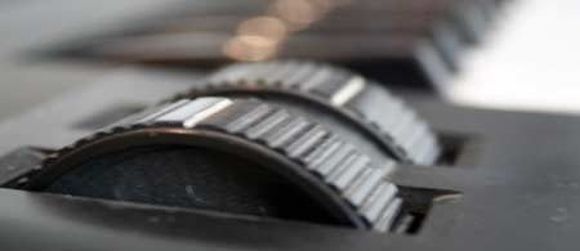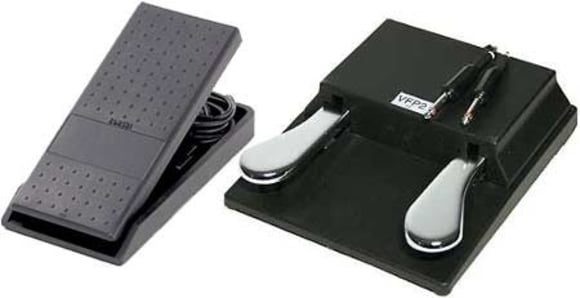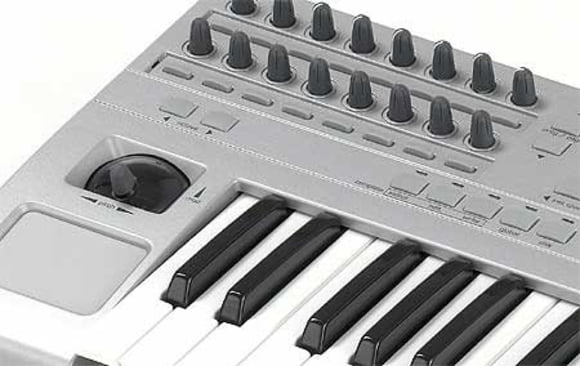4. Standard Controls
Many master keyboards allow the player to do a great deal more than simply play notes. MIDI connections carry many different control signals used to manipulate sounds and to affect the programming of sound modules and other devices. Lets take a look at the most important types of control data along with the keyboard features usually associated with them:
Velocity
Along with pitch, one of the most important pieces of data accompanying every MIDI note is its velocity. This tells the instrument receiving the data how hard each note has been struck. It is vital to the realism of most sampled acoustic sounds like those from a piano and also to the expressive possibilities for many synth sounds. Where it is not relevant, the instruction is simply ignored for example, a realistic organ sound does not respond to velocity data. In the past, the cheapest keyboards were not velocity sensitive at all, so velocity sensitivity was advertised as a selling point. Now though all but a few keyboards have it, so the fact is often not even mentioned.
Many master keyboards feature a number of selectable velocity curves. These affect the relationship between the physical force with which a note is played, and the number used to represent it in data. In simple terms, this makes a sound more or less responsive to physical forces.
Velocity refers by default to note-on velocity the force with which a key is pressed. Its logical counterpart is note-off velocity the speed at which it is released. Not all keyboards implement this instruction, and most sounds do not respond to it.
Pitch Bend
This control allows notes to be bent up or down in pitch as they sound and is usually controlled by a pitch wheel placed directly to the left of the keyboard. As pitch bend is generally only appropriate for monophonic lines the wheel usually springs back to its centre position (no bend) when released. The actual pitch range depends on the sound in use (often +/- one semitone, one tone or one octave).
Modulation
The modulation or mod wheel is usually found next to the pitch wheel and is commonly physically identical, except that it generally retains its position when released. Modulation is a somewhat vague term in this context - the mod wheel usually adds some sort of effect such as vibrato or tremolo, but can also be used to control other parameters such as filter cut-off frequency and the balance between discrete components within a sound.
Aftertouch (Pressure)
This control allows the player to affect some aspect of the note while they key is pressed, usually vibrato or tremolo, giving the player much freer control of these techniques than can be achieved by using the mod wheel. By continuously varying finger pressure, expression is literally squeezed from the note in a manner similar to that used when playing a stringed instrument with vibrato.
Unless otherwise stated, this is almost always monophonic aftertouch - pressure applied to any key affects all notes being played. Polyphonic aftertouch is relatively rare and is often used as a yardstick by which the most advanced keyboards are marketed. Polyphonic aftertouch allows individual keys to send their own independent aftertouch data, however this is ignored by most MIDI instruments.
Pedals
Most keyboards have a sustain pedal connection. Pressing the pedal results in a MIDI signal, causing notes to sustain after keys have been released. This is important for realistic piano sounds, but may also be used to create crescendo effects as the number of sounding voices increases.
More advanced master keyboards usually incorporate a number of other pedal connections including the other two grand piano pedals (una corda/damper and sostenuto), as well as volume pedals and switch pedals which may be used for various functions including patch/program change (see below).
Control Knobs
Many sound modules and software instruments respond to a range of MIDI controls beyond simple pitch bend and modulation. These include filter and envelope parameters, oscillator frequencies, balance between components within a sound and just about anything else you can think of. Dedicated controller hardware does exist, but many master keyboards also include a dozen or more knobs and sliders for this purpose.
Program/Bank Change/Presets
Most MIDI sound sources respond to program/bank change messages. This allows sounds to be changed remotely, either directly by number or via up/down messages. More advanced implementations of this idea allow the controller to store presets so that the sounds required for a particular gig can be easily accessed in order, even though they may not have adjacent program numbers on the sound module, or indeed come from completely separate modules.
Split/Zone Functions
Most controller keyboards have a simple split function, allowing the top and bottom halves of the keyboard to send their data on separate MIDI channels, for example to allow playing strings with the right hand and piano with the left. Zones offer a more sophisticated version of this idea - typically all zones may be defined independently. For example, Zone 1 may be made to cover the entire keyboard sending on Channel 1, while Zone 2 adds strings above middle C on Channel 2, and Zone 3 is assigned to only one note and triggers a gong sound on Channel 3 intoxicating power!
Octave/Transpose
The transpose function allows the player to transpose the note data sent by a given number of semitones (very useful when a singer asks you to take it up a third). Octave buttons simply transpose the range in steps of one octave. This permits access to notes beyond the keyboards physical range, and is particularly useful on smaller keyboards.





